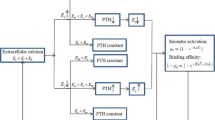Abstract
The temporal behaviour of the nonlinear compartmental model we have developed for rat calcium metabolism is discussed with respect to the theoretical properties of the self-oscillating autocatalytic subunit around which the model is constructed. Depending on the approximations made, this subunit is described by a minimal two-variable model, SU2, or by a three-variable one, SU3. The diversity of the theoretical dynamic behaviours possible with SU2 is greatly increased with SU3. But the identification of SU3 parameter values in three different experimental situations reveals that biological constraints efficiently preserve a simple circadian rhythm for bone metabolism. This analysis indicates the significant contribution of the available bone crystal pool to the dynamic organization of this tissue, and hence to extracellular calcium homeostasis.
Similar content being viewed by others
References
Golubitsky M. and W.F. Langford (1981). Classification and unfoldings of degenerate Hopf bifurcations, J. Diff. Equat. 41: 375–415.
Guckenheimer J. and P.H. Holmes (1983). Nonlinear Oscillations, Dynamical Systems and Bifurcations of Vector Fields. Springer Verlag.
Rader J.I., D.J. Baylink, M.R. Hughes, E.F. Safilian and M.R. Haussler (1979). Calcium and phosphorus deficiency in rats: effects on PTH and 1,25-dihydroxyvitamin D3. Am. J. Physiol. 236: E118-E122.
Rusli I.T., G. Schrader and M.A. Larson (1989). Raman spectroscopic study of NaNO3, solution system- solute clustering in supersaturated solutions. J. Crystal Growth 97: 345–351.
Staub J.F., A.M. Perault-Staub and G. Milhaud (1979). Endogenous nature of circadian rhythms in calcium metabolism. Am. J. Physiol. 237: R311-R317.
Staub J.F., P. Tracqui, P. Brezillon, G. Milhaud and A.M. Perault-Staub (1988). Calcium metabolism in the rat: a temporal self-organized model. Am. J. Physiol. 254: R134-R139.
Tracqui P., P. Brezillon, J.F. Staub, A.M. Perault-Staub and G. Milhaud (1985). Diversity and complexity of temporal dynamic behaviors for a simple autocatalytic model, C. R. Acad. Sc. Paris, Ser. II, 300: 253–258.
Tracqui P., A.M. Perault-Staub, G. Milhaud and J.F. Staub (1987). Theoretical study of a two dimensional autocatalytic model for calcium dynamics at the extracellular fluid-bone interface. Bull. Math. Biol. 49: 597–613.
Tracqui P., J.F. Staub and A.M. Perault-Staub (1989). Analysis of degenerate Hopf bifurcations for a nonlinear model of rat metabolism. Nonlin. Anal. Th. Meth. Appl. 13: 429–457.
Author information
Authors and Affiliations
Rights and permissions
About this article
Cite this article
Tracqui, P., Staub, J.F. & Perault-Staub, A.M. Modelling of in vivo calcium metabolism. II. Minimal structure or maximum dynamic diversity: the interplay of biological constraints. Acta Biotheor 40, 103–111 (1992). https://doi.org/10.1007/BF00168139
Published:
Issue Date:
DOI: https://doi.org/10.1007/BF00168139




